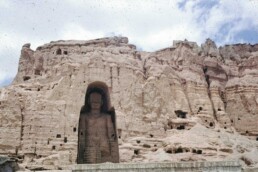In the ancient heart of Central Asia, where towering mountains embrace sprawling desert landscapes, lies Afghanistan—a land steeped in history and teeming with tales of trade and transformation. Picture a scene from centuries past: dusty caravanserais spring to life with the arrival of traders, their camels laden with precious silks, exotic spices, and ancient manuscripts. Here, amidst the rugged terrain and bustling marketplaces, Afghanistan stood as a vital crossroads on the Silk Road, where East met West in a grand tapestry of commerce and culture. This storied crossroads has witnessed the rise and fall of empires, the mingling of diverse peoples, and the flow of ideas and goods that shaped the course of history.
The Silk Road, an intricate web of commercial routes connecting China and the Mediterranean, served as a conduit for cultural and intellectual exchange as well as a means of transportation. Afghanistan, with its steep terrain and strategic location, served as an important link in this huge network. The region’s history is marked by the emergence and collapse of empires that exploited its potential as a commerce hub. The Greco-Bactrian Kingdom, the Kushan Empire, and subsequently the Sassanian and Islamic Caliphates recognised the importance of Afghanistan’s position. Balkh, sometimes known as the “Mother of Cities,” was a thriving cultural and commercial centre. Scholars, traders, and travellers from all backgrounds gathered here, trading not only products but also ideas and innovations.
During the Kushan Empire (approximately 30-375 CE), Afghanistan saw one of its most amazing times on the Silk Road. The Kushans, descended from the Yuezhi tribes, founded a monarchy that spanned modern-day Afghanistan, northern India, and parts of Central Asia. Cities such as Bamiyan and Kabul thrived as melting pots of Greek, Persian, Indian, and Central Asian cultures during the Kushan era. The Kushans helped disseminate Buddhism from India to China via the Silk Road. The iconic Bamiyan Buddhas, huge statues carved into the cliffs of the Bamiyan Valley, are a witness to this cultural blending. Despite their sad destruction in 2001, these statues continue to represent Afghanistan’s rich historical heritage.
Samarkand, a prominent Silk Road stop in northern Afghanistan, was another important trading and cultural centre. While Samarkand is not in present-day Afghanistan, its historical impact on the region was significant. As merchants and academics travelled the Silk Road, they regularly passed through Afghanistan. The interchange of items including textiles, ceramics, and precious stones helped Afghan cities develop. This age also saw the introduction of new technology and ideas, including as advances in astronomy, mathematics, and medicine, which spread across the region via the Silk Road. This cross-cultural interaction fuelled the creation of a complex urban culture that distinguished many Afghan cities.
Afghanistan’s importance on the Silk Road changed dramatically during the 7th and 8th centuries as Islam spread. The Umayyad Caliphate’s expansion into Central Asia created new trade routes, further integrating Afghanistan into the Islamic world. The Abbasid Caliphate, which succeeded the Umayyads, inaugurated a golden period of cultural and scientific progress. Cities such as Herat and Ghazni have arisen as thriving centres of Islamic culture and learning. The scholarly work created in these cities left an indelible mark on the intellectual landscape of the time. The Persian polymath Avicenna, also known as Ibn Sina, was a major person during this period. Avicenna, who was born in the region, made significant contributions to medicine, philosophy, and natural sciences. His publications, particularly “The Canon of Medicine,” had a significant impact in both the Islamic world and mediaeval Europe, illustrating Afghanistan’s significance as a link between East and West.
The emergence of the Mongol Empire in the 13th century represented another watershed moment for Afghanistan. Genghis Khan’s conquests, followed by Timurid reign, changed Central Asia’s political environment. Despite the bloodshed and chaos, the Mongol era enabled additional cross-cultural interactions. The Timurids, noted for their encouragement of the arts and architecture, left an indelible mark on the region. Under Timur’s leadership, Herat rose to prominence as a centre of art, literature, and scholarship. The Timurid architectural style, known for its elaborate tile work and large monuments, continues to influence Afghan architecture today.
The fall of the Silk Road, caused in part by the growth of maritime trade routes and the Ottoman Empire’s dominance, was a fundamental shift in Afghanistan’s historical trajectory. The regional trade patterns shifted, but Afghanistan’s legacy remained a reminder of its former splendour. The relics of ancient cities, the echoes of former empires, and the persisting cultural interactions all contribute to a complicated and interesting story.
Today, Afghanistan’s heritage serves as both a reminder of its past and a beacon for future discovery. The old trade routes may have shrunk in their original shape, but the spirit of commerce and connection that distinguished the Silk Road persists. Afghanistan is a testimony to the Silk Road’s long-lasting legacy, reminding us of a period when faraway places were brought together by a shared desire of riches and knowledge. As we reflect on this illustrious past, we acquire a better understanding of how trade and culture interacted on this ancient route, changing the course of history and enriching the fabric of human civilisation.
The Silk Road’s influence on Afghanistan is a stark reminder of how interwoven our globe has always been. This old trade network’s legacy lives on in Afghanistan’s cultural and historical fabric, providing unique insights into the trade, culture, and civilisation forces that have defined our collective past. Exploring this rich past not only reveals the complexities of ancient commerce, but also provides a better understanding of how human interactions have crossed geographical and temporal boundaries.



